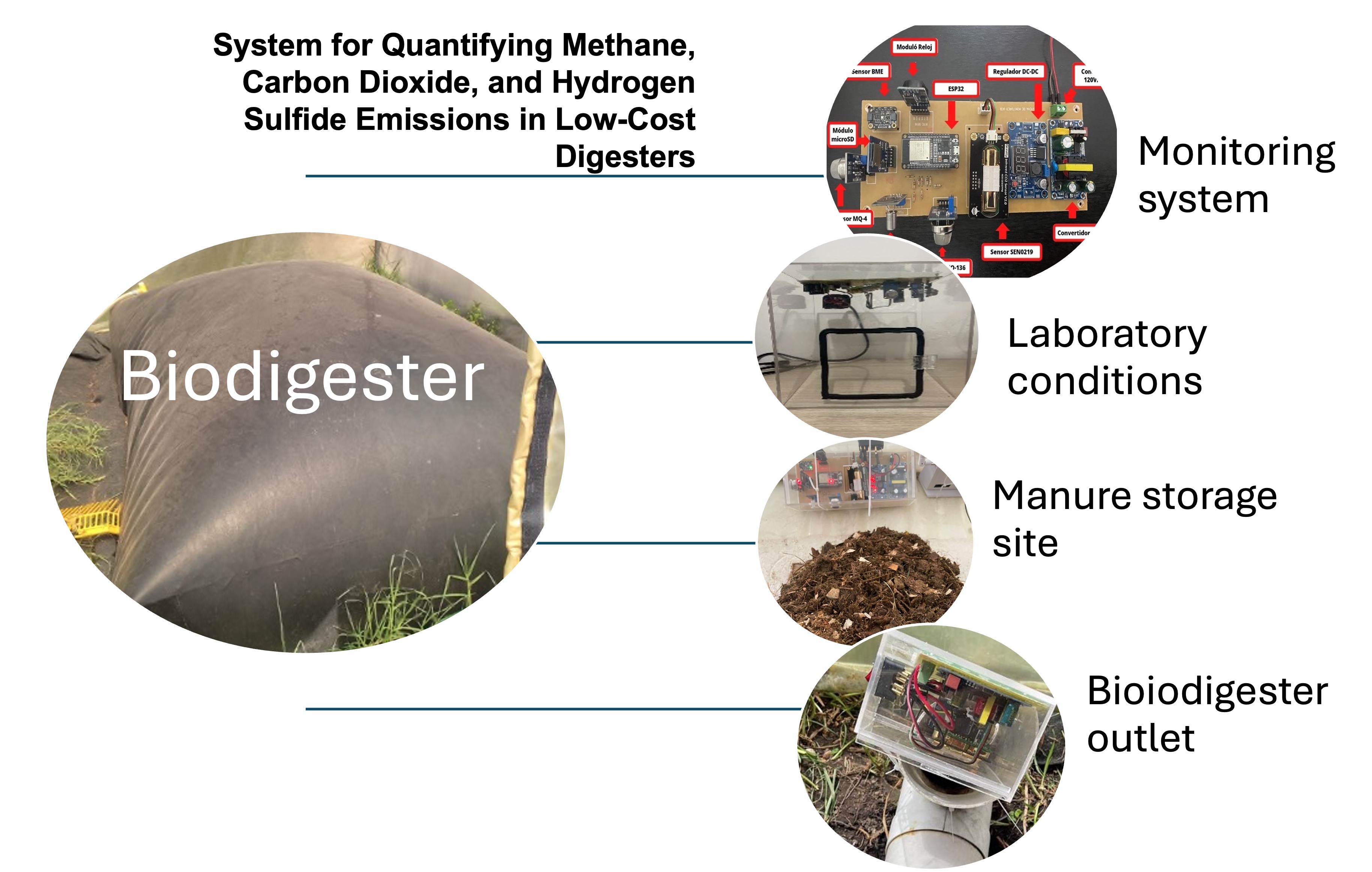System for Quantifying Methane, Carbon Dioxide, and Hydrogen Sulfide Emissions in Low-Cost Digesters Inoculated with Horse Manure

Published 2024-11-20
Keywords
- Greenhouse gases,
- Temperature control,
- Organic waste,
- Horse manure,
- Monitoring
How to Cite
Copyright (c) 2024 Yudtanduly Acuña, Laura Sofia Mecón Rodríguez, Daniel Molina Martinez

This work is licensed under a Creative Commons Attribution-NoDerivatives 4.0 International License.
Abstract
Methane CH₄ and carbon dioxide CO₂ are the primary gases produced during anaerobic digestion AD, followed by what is referred to as “other gases,” a highly variable group depending on the type of organic matter being digested. However, one of the most notable and common gases is hydrogen sulfide (H₂S), a gas that, while not a greenhouse gas, is well-known for its corrosive effects and its impact on health and the environment [1].
To quantify gas emissions associated with the treatment of horse manure at the Cavalry Canton of the National Army of Colombia, a direct monitoring system was implemented. Over 45 days, measurements of CH₄, CO₂, and H₂S were conducted using sensors such as the MQ-4, TGS 2611, SEN 0219, and MQ-136, respectively. The measurement ranges of the instruments used were: (200 – 10,000 ppm, 500 – 12,500 ppm, 0 – 5000 ppm, and 0 – 200 ppm), with detection levels of: (10 ppm, 0.1 – 0.65 ppm, 40 ppm, 30 ppm). These instruments were placed in three key scenarios: the manure storage site, the biodigester outlet, and under controlled laboratory conditions. The objective was to generate a detailed analysis of the behavior of these emissions.
As a result, theoretical estimates of CH₄ and CO₂ equivalents were calculated for the Cavalry Canton. These theoretical estimates were compared with the data obtained from the monitoring and showed reductions ranging from 8 to 87 % for CH₄, 58 to 67 % for CO₂, and 33 to 65 % for H₂S. These figures highlight the effectiveness of the implemented system in detecting gas emissions of interest from horse manure management, significantly contributing to environmental sustainability.
Downloads
References
- Martínez-Villalba JA, Lemus-Camacho ML, Esquivel-Treviño NL, Oliveros-Muñoz JM. Cuantificación de H2S empleando filtro de hierro en biodigestores. ET [Internet]. 2023;15(39):1-23. https://doi.org/10.59057/iberoleon.20075316.202339538
- Nabuurs G-J, Delacote P, Ellison D, Hanewinkel M, Hetemäki L, Lindner M. By 2050 the Mitigation Effects of EU Forests Could Nearly Double through Climate Smart Forestry. Forests. 2017;8(12):484. https://doi.org/10.3390/f8120484
- CEPALSTAT. Emisiones de Gases de Efecto Invernadero (GEI) por sector [En línea]. 2020. Available from: https://statistics.cepal.org/portal/cepalstat/dashboard.html?theme=3&lang=es [Accessed on: 1-3-2023]
- Pipatti R, Manso Vieira SM. Desechos. En: Directrices del IPCC de 2006 para los inventarios nacionales de gases de efecto invernadero. Eggleston HS, Buendia L, Miwa K, Ngara T, Tanabe K. (eds). Japón: IGES; 2006.
- Osorio Saraz JA, Ciro Velásquez HJ, González Sánchez H. Evaluation of a biodigester system in series for cold climate. Rev. Fac. Nal. Agr. Medellín. 2007;60(2):4145-4162.
- Martí-Herrero J. Biodigestores tubulares. Guía de Diseño y manual de Instalación. CIMNE BEE Group; 2019.
- DEAM, PNUD, Alcaldía de Bogotá, Gobernación de Cundinamarca, CAR, Corpoguavio, Instituto Alexander von Humboldt, Parques Nacionales Naturales de Colombia, MADS, DNP. Inventario de Gases de Efecto Invernadero de la Región Bogotá -Cundinamarca. Bogotá, Colombia; 2012.
- León GE, Benavides HO. Información técnica sobre gases de efecto invernadero y el cambio climático. Instituto de Hidrología, Meteorología y Estudios Ambientales–IDEAM. Bogotá, Colombia; 2007.

